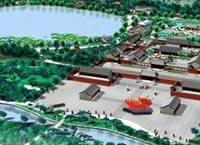
Beijing plans to rebuild the 230-year-old Tuanhe Imperial Palace, the largest temporary imperial dwelling in the city.
Located in the southern outskirts of the capital, the palace was built in 1772 during the heyday of the Qing Dynasty (1644-1911) and destroyed by war disasters in the 19th century.
Only two of the 600-plus structures in the palace grounds are still standing.
The multi-million-dollar project will likely be started by the end of the year, announced the Beijing Cultural Relics Bureau yesterday.
Most of the ancient buildings will be rebuilt based on their original patterns, said Wang Fuyu, an official with the bureau's Relics Protection Division.
She said relics experts have found a plan of the palace drafted during the reign of Emperor Guangxu (1875-1908), as well as several building designs from that time.
"The construction work will strictly keep in line with the old designs and all the work will use traditional Chinese building techniques," said Wang.
The Tuanhe Imperial Palace, covering an area of 33 hectares, is located in the west side of the extension line of the city's central axis.
Wang said the palace was built by Emperor Qianlong (1711-1799) -- one of the most influential rulers of the Qing Dynasty, as a resting place after hunting at the Nanhaizi Field nearby.
The Tuanhe Palace was also an important office complex during the Qing Dynasty. Emperor Qianlong and later emperors, as well as the Empress Dowager (1835-1908), all spent a period of time every year at the palace.
Liu Yuquan, head of the Cultural Committee of Daxing District where the Tuanhe Palace is located, said the massive rebuilding project is divided into two phases and is scheduled to be completed by 2007.
The first phase includes the reconstruction of most structures inside the palace wall, including halls, scenic spots, hills and lakes.
The first phase is expected to cost at least tens of millions yuan, but exact numbers have not been calculated yet, said Liu, who is also deputy director of the project.
The second phase will focus on the reconstruction of the seven residences of Qing princes and more than 100 houses for workers who lived outside the palace wall, said Liu.
He said when the project is finished in three years, the palace will open to the public.
Visitors will not only be able to examine the imperial buildings and beauty of the scenic spots, but also study the ancient architecture, clothing and food.
Kang Reizheng, a relics adviser to the project, said tourists coming to Beijing would be well advised to visit two imperial spots. One is the Forbidden City at the heart of Beijing, and the other one is the Tuanhe Palace.
However, Wang Shiren, a renowned relics experts, feared there will not be enough money for quality construction.
He said the reconstruction should match the quality of building during the reign of Emperor Guangxu, which can be seen at the Summer Palace, a famous imperial garden located in northwestern outskirts of Beijing.
(China Daily October 28, 2004)
|

